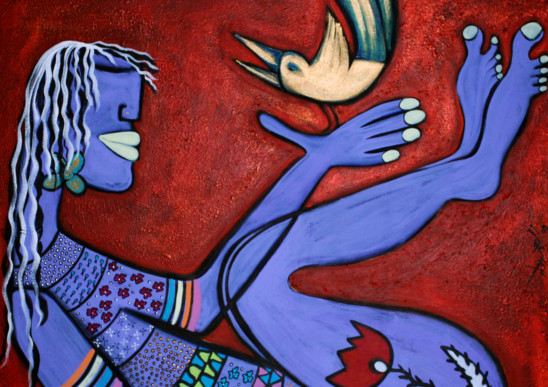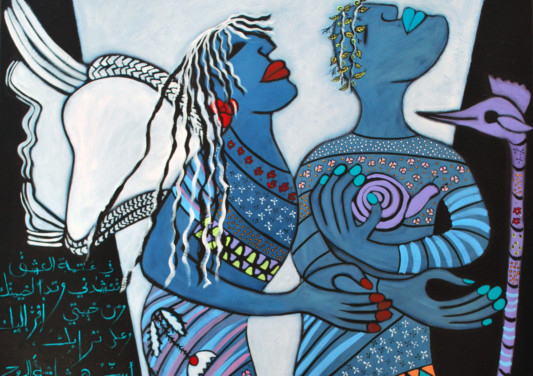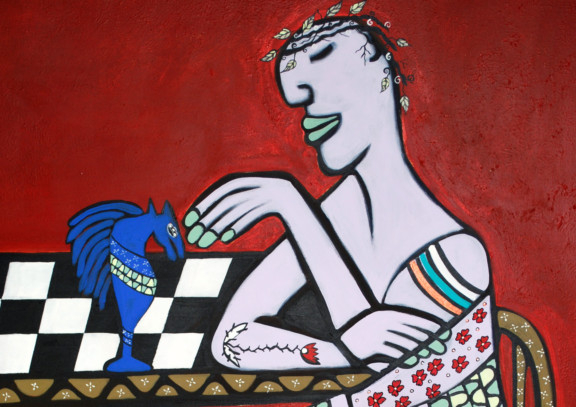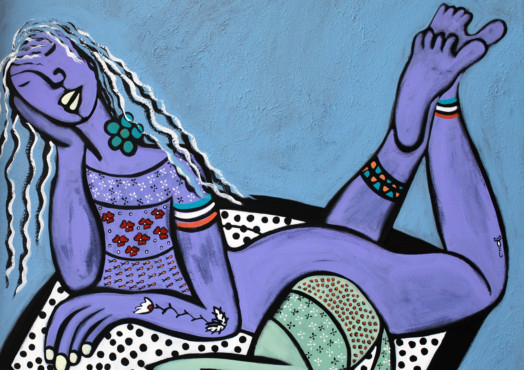
Emirati artist Wafa Khazendar is also an award-winning writer and poet. She has published two anthologies of poetry and a collection of short stories. And her paintings are often inspired by her poems. The latest exhibition by Khazendar, who is of Palestinian origin, is called “Emotions” and comprises a series of colourful, acrylic paintings, featuring her as the central character.
“For me writing and painting are ways of exploring my innermost thoughts, feelings and dreams and discovering myself. I believe in expressing myself with total freedom and am often surprised by the images and ideas that emerge from my subconscious. The way different people interpret my work also helps me to learn more about myself and about human emotions in general,” she says.
Like her poems and stories, Khazendar’s paintings deal with issues of gender, man-woman relationships, suppression of women and the human desire for freedom and self-expression. Every painting tells a story that most women will connect with instantly. But the stories also urge both men and women to think deeply about their thoughts, actions and expectations from themselves and from each other.
In one of her most thought-provoking paintings, she has depicted a bird locked up inside a lush green enclosure, while a man is seen resting below, with the keys to the enclosure casually held between his toes. The composition invites viewers to think about the mental and emotional prisons of our own making that we often dwell in, and are afraid to break out from. “The man is confidently asserting his ownership over the enclosure and the bird. But the truth is that the bird can easily fly away if it wants to. However, it chooses to stay in this beautiful prison till he unlocks the door. We, the women, are like this bird, who has allowed this man to have such power over her. We willingly live in beautiful prisons, meekly waiting to be released and then wonder why we are not happy,” Khazendar says.
The mood is different in another canvas, where the man is depicted as a cat with a big moustache. And the woman appears to be toying with his feelings, playfully luring him with various objects. “This painting is based on a poem I wrote when I was feeling angry and restless. But now it looks to me like a depiction of Scheherazade, who kept her murderous husband enthralled with her unending stories for a thousand and one nights. I am also a storyteller, and perhaps this is about my need for somebody to listen to me,” Khazendar says.
Another painting is directly related to a specific incident in her life. Here the artist is sitting on a couch, wistfully looking at a bird. “Recently I was invited to participate in a poetry reading session in Bahrain, but my husband did not allow me to go. I was sad and angry and wanted to be left alone. And really wished I could be like the bird, free to fly wherever I wanted,” she says.
In many of her paintings, Khazendar has depicted men as peacocks with elongated necks and heads held high. But she also shows herself in the same way, to express her belief that women are equal to men and must respect themselves. She highlights the gender inequality that exists in our society in another painting based on a poem. Here the woman is shown as a winged angel looking after the man. But he is blind and walking off on his own path, guided by a stick with a peacock’s head. In his other hand he holds a snail, as a symbol of his life. And he wears a laurel wreath around his head to assert that he is always a winner. “She is like an angel always wanting to look after him. But he wants to be left alone and live life in his way. His pride and his belief that he is always right make him blind to her feelings,” Khazendar says.
Many of the paintings reflect the artist’s longing to go back to her carefree childhood, and show her playing on a rocking horse or with a rag doll. “This rag doll appears often in my paintings. I don’t know why, but to me it represents my soul,” she says. Other recurring motifs in her work include birds that represent freedom, cats that are symbols of companionship and sea horses — creatures she likes because it is the male of the species that carries the babies in its pouch.
She also likes to decorate the figures in her paintings with a variety of textures and colourful motifs such as flowers, leafy vines and other patterns. “I am quite a cheerful person, but my paintings show the sadness that exists deep inside me. The colourful patterns, the bright nail polish and other adornments on these figures contrast with their pensive expressions and reflect the balance that we all seek between our inner and outer self. My paintings tell my story. But it is also the story of every woman,” Khazendar says.
Jyoti Kalsi is an arts enthusiast based in Dubai.
“Emotions” will run at Arteberry, Dubai Media City, Building 8, until July 22.






